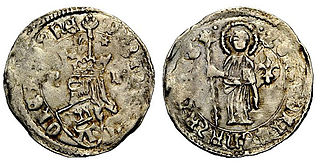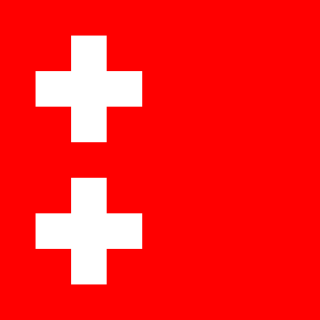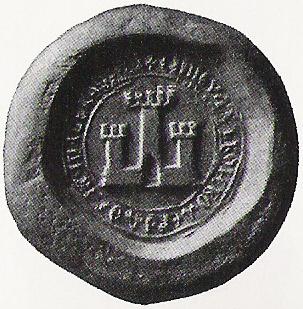
Stephen Tvrtko I was the first king of Bosnia. A member of the House of Kotromanić, he succeeded his uncle Stephen II as the ban of Bosnia in 1353. As he was a minor at the time, Tvrtko's father, Vladislav, briefly ruled as regent, followed by Tvrtko's mother, Jelena. Early in his personal rule, Tvrtko quarrelled with his country's Roman Catholic clergy but later enjoyed cordial relations with all the religious communities in his realm. After initial difficulties—the loss of large parts of Bosnia to his overlord, King Louis I of Hungary, and being briefly deposed by his magnates—Tvrtko's power grew considerably. He conquered some remnants of the neighbouring Serbian Empire in 1373, after the death of its last ruler and his distant relative, Uroš the Weak. In 1377, he had himself crowned king of Bosnia and Serbia, claiming to be the heir of Serbia's extinct Nemanjić dynasty.

Đurađ Vuković Branković was the Serbian Despot from 1427 to 1456. He was one of the last Serbian medieval rulers. He was a participant in the battle of Ankara (1402) and Ottoman Interregnum (1403–1413). During his reign, the despotate was a vassal of both Ottoman sultans as well as Hungarian kings. Despot George was neutral during the Polish-Lithuanian (1444) and Hungarian-Wallachian (1448) crusades. In 1455, he was wounded and imprisoned during clashes with the Hungarians, after which the young Sultan Mehmed II launched the siege of Belgrade and its large Hungarian garrison. Despot Đurađ died at the end of 1456, due to complications stemming from the wound. After his death, Serbia, Bosnia and Albania became practically annexed by sultan Mehmed II. Đurađ attained a large library of Serbian, Slavonic, Latin, and Greek manuscripts. He made his capital Smederevo a centre of Serbian culture. He was the first of the Branković dynasty to hold the Serbian monarchy.

The Serbian Despotate was a medieval Serbian state in the first half of the 15th century. Although the Battle of Kosovo in 1389 is mistakenly considered the end of medieval Serbia, the Despotate, a successor of the Serbian Empire and Moravian Serbia, lasted for another sixty years, experiencing a cultural, economic, and political renaissance, especially during the reign of Despot Stefan Lazarević. After the death of Despot Đurađ Branković in 1456, the Despotate continued to exist for another three years before it finally fell under Ottoman rule in 1459.

Hrvoje Vukčić Hrvatinić was a medieval Bosnian nobleman and magnate, Grand Duke of Bosnia, Knez of Donji Kraji, and Duke of Split. He was the most prominent member of the Hrvatinić noble family, and one of the major feudal lords in Kingdom of Bosnia. He was Grand Duke of Bosnia under three Bosnian kings: King Tvrtko I, King Stephen Dabiša and King Stephen Ostoja. In 1403, and after Tvrtko I's death, Ladislaus of Naples named him his deputy for Dalmatia, and bestowed him with a title Duke of Split, later Herzog of Split. He played a crucial role in the dynastic struggles between the Anjou and Luxembourg claimants to the Hungarian-Croatian throne at the end of the 14th century, as well as in the emergence of the Bosnian Kingdom as a regional power during the same period.

The history of Bosnia and Herzegovina in the Middle Ages refers to the time period between the Roman era and the 15th-century Ottoman conquest. The Early Middle Ages in the Western Balkans saw the region reconquered from barbarians (Ostrogoths) by the Byzantine Emperor Justinian I, followed by raids and migrations carried out by Slavic peoples in the 6th and 7th centuries. The first mention of a distinct Bosnian region comes from the 10th-century Byzantine text De Administrando Imperio. By the late 9th and early 10th century, Latin priests had Christianized much of Bosnia, with some areas remaining unconverted. In the High Middle Ages, Bosnia experienced economic stability and peace under the Ban Kulin who ruled over Banate of Bosnia from 1180 to 1204 and strengthened its ties with the Republic of Ragusa and with Venice. The Kingdom of Bosnia emerged in the Late Middle Ages (1377). The kingdom faced internal and external conflicts, eventually falling under Ottoman rule in the late 15th and early 16th centuries.
Helen, also known by the name Gruba/Груба, ruled the Kingdom of Bosnia from September 1395 until late April or early May 1398. She was queen consort as the wife of King Dabiša, and was chosen by the stanak to rule after his death. Whether she was a regent who ruled during an interregnum or a queen regnant is disputed, but in any case the real power was held by magnates of the kingdom. Her rule ended with the election of King Ostoja.
Stephen Ostoja was King of Bosnia from 1398 to 1404 and from 1409 to 1418.
Stephen Thomas, a member of the House of Kotromanić, reigned from 1443 until his death as the penultimate king of Bosnia.
Vladislav Hercegović was oldest son of Stjepan Vukčić. The Kosača noble family held lands in the region known as Humska zemlja, later named Herzegovina.

Stephen Tvrtko II, also known as Tvrtko Tvrtković, was a member of the House of Kotromanić who reigned as King of Bosnia from 1404 to 1409 and again from 1420 to his death.

The House of Kosača, somewhere Kosačić, was a Bosnian medieval noble family which ruled over parts of modern-day Bosnia and Herzegovina, Croatia, Montenegro, and Serbia between the 14th century and the 15th century. The land they controlled was known as Humska zemlja, roughly corresponding to modern region of Herzegovina, which itself was derived from the title "Herzog", which Stjepan Vukčić Kosača adopted in 1448., with latin title "Dux Sancti Sabbae". Besides Hum, they ruled parts of Dalmatia and Rascia. They were vassals to several states, including the Kingdom of Bosnia and Ottoman Empire. Historians think the Kosača family is part of the Kőszegi family, but there is a lack of evidence for this claim.
The religious confession of the Kosača family is uncertain. They were in contact with the Eastern Orthodox Church, the Church of Bosnia, the Roman Catholic Church and Islam. During the fall of the Bosnian Kingdom, the "Kosače" split into three branches: Venetian, Dalmatian and Ottoman. From then onward, these branches became accepting of the Roman Catholic faith, in the first two cases, and of Islam in the third.

Old Herzegovina is a historical region, covering the eastern parts of historical Herzegovina, outside the scope of modern Herzegovina. A large section of Old Herzegovina belongs to modern Montenegro, while a smaller section belongs to the modern Bosnia and Herzegovina and modern Serbia. All of those regions were parts of historical Herzegovina from the middle of the 15th century until 1878.

The Duchy of Saint Sava was a late medieval polity in southeastern Europe, that existed from 1448 up to 1482, when it was absorbed by the Ottoman Empire. It was founded and controlled by the Kosača noble family, whose rulers held the title Duke of Saint Sava. Their domains included southern parts of modern-day Bosnia and Herzegovina, extending to southern parts of modern-day coastal Croatia, northwestern Montenegro and southwestern Serbia. Its founder, Stjepan Vukčić Kosača, titled himself Herceg of Saint Sava, a title which would later give rise to the new name to the region: Herzegovina, and will be also used by the Ottomans as Hersek Sancağı, designating the Sanjak of Herzegovina.

Herzegovina is the southern and smaller of two main geographical regions of Bosnia and Herzegovina, the other being Bosnia. It presently does not have strictly defined administrative borders; however, in the past it was organized as Sanjak of Herzegovina and Herzegovina Eyalet (1833–1851).

Stjepan Vukčić Kosača (1404–1466) was a powerful Bosnian nobleman who was politically active from 1435 to 1465; the last three decades of Bosnian medieval history. During this period, three kings acceded to the Bosnian throne: Tvrtko II, Thomas (Tomaš), Stephen Tomašević (Stjepan Tomašević) and anti-king Radivoj—the older brother of King Thomas—before the country was conquered by the Ottomans.

The Kingdom of Bosnia, or Bosnian Kingdom, was a medieval kingdom that lasted for nearly a century, from 1377 to 1463, and evolved out of the Banate of Bosnia, which itself lasted since at least 1154.
The Ottoman conquest of Bosnia and Herzegovina was a process that started roughly in 1386, when the first Ottoman attacks on the Kingdom of Bosnia took place. In 1451, more than 65 years after its initial attacks, the Ottoman Empire officially established the Bosansko Krajište, an interim borderland military administrative unit, an Ottoman frontier, in parts of Bosnia and Herzegovina. In 1463, the Kingdom fell to the Ottomans, and this territory came under its firm control. Herzegovina gradually fell to the Ottomans by 1482. It took another century for the western parts of today's Bosnia to succumb to Ottoman attacks, ending with the capture of Bihać in 1592.

The House of Talovac was a Croatian noble family, descending from the island of Korčula and reaching its peak in the 15th century in the Kingdom of Croatia, at that time in personal union with Hungary. The members of the family rose to high state, church or military offices, such as Ban (Viceroy) of Croatia and Dalmatia as well as Ban of Whole Slavonia, royal court chamberlain, bishop, župan and others.

Radoslav Pavlović, sometimes spelled Radislav, Radisav or Radosav, was a Bosnian nobleman of the noble family Pavlović-Radinović. He inherited title of knez from his father Pavle Radinović upon his father death, while his older brother Petar (1415–1420), being the first in order of precedence, was bestowed a title of duke by the Bosnian throne. He and his brother also inherited their father's estates in the eastern parts of the Kingdom of Bosnia. After the murder of his father Pavle Radinović on Parena Poljana, near Sutjeska and Bobovac, in 1415 by the hand of Grand Duke of Bosnia, Sandalj Hranić (1392–1435), Radosav together with his older brother Peter, started a war against Sandalj Hranić and his Kosača clan, as those responsible for the murder. After the death of his older brother Petar in the conflict with the Ottomans in 1420, Radosav assumed leadership over the Pavlović's clan and took over the title of duke, and around 1421 he was bestowed a title of Grand Duke of Bosnia by the throne. He ended the conflicts with the Kosača and sealed the peace with a marriage with the daughter of Vukac Hranić, princess Teodora, the sister of the future Kosača's clan chieftain, Stjepan Vukčić (1435–1466), with whom he had three sons. In 1426, he sold his part of Konavle to the Republic of Ragusa for 18,000 perpers, but in 1430 he started the so-called First Konavle War over the sold territories, which ended in 1432 with the recognition of the situation from the beginning of the conflict. In 1435, after the death of Duke Sandalj Hranić, he tried to take advantage of the new situation, but in a conflict with his wife's brother Stjepan, he eventually lost the southern parts of his zemlja around Trebinje. He died in 1441, and was succeeded by his son Ivaniš Radoslavić Pavlović (1441–1450).
Petar Kovačević was a duke from the Bosnian Dinjčić noble family, which had its estates in the eastern parts of the medieval Bosnian state, in the Jadar region. He was the son of Kovač Dinjčić.













